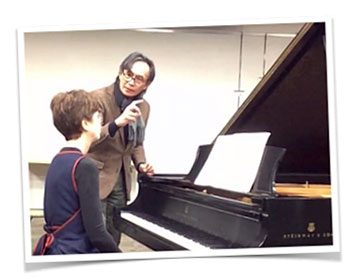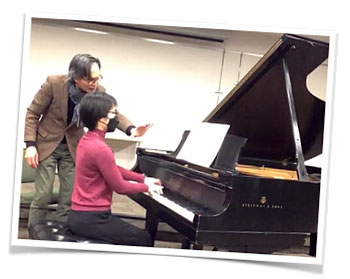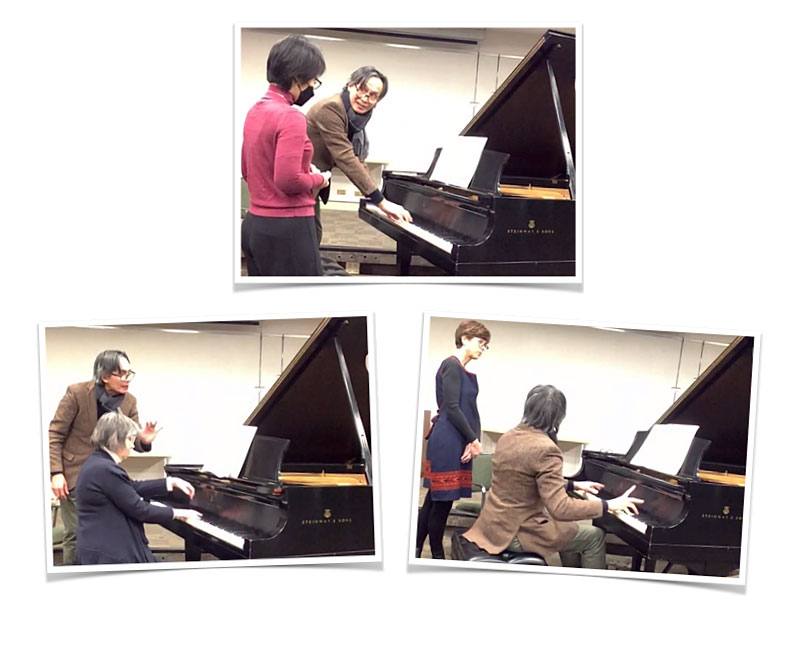Music Educators Association of New Jersey
Serving teachers and students since 1927


 Eduardus Halim
Eduardus HalimEduardus Halim, distinguished pianist and teacher, conducted the class in the Chase Room of the Madison Library for an audience in the auditorium and online via Zoom (assisted by Lisa Gonzalez). President Yudit Terry’s greetings were followed by introductory remarks of Beverly Shea, program coordinator. Mr. Halim has enjoyed a remarkable career in international performance. An ethnic Chinese born in Indonesia, he studied with Sascha Gorodnitski and Rudolf Firkusny at Juilliard and later became Vladimir Horowitz’s last pupil, studying with him for a year. He is currently a member of the N.Y.U. faculty. See also eduardushalim.com/bio.html.
The program consisted of three segments, each featuring a beautiful performance by an MEA teacher followed by the insightful coaching of Eduardus Halim, The inspiring master teacher commented on general topics such as phrasing, pedaling, dynamics, tempo, and frequently played excerpts from the scores. It was a fascinating session.
Frédéric Chopin’s Nocturne in D-flat major, Op. 27, No. 2, performed by Karen Dalley: Mr. Halim first stated that we must “make the piano sing. Legato is one of the most important elements for expression. One must also consider the pedaling. This piece requires legatissimo.” The melody is so familiar, but pedaling can alter the texture to give each repetition a distinct character. Mr. Halim demonstrated how dynamics and articulation shape each phrase: “Is it singing or is it speaking?” Legato passages are singing, but some portato spots are parlato (speaking).  Think opera. He shaped his dynamics in a short melodic line, falling away to a pianissimo. Doing so makes the interpretation more intimate, he opined. In measure five, bring out the change in harmony using dynamics and pedal. Throughout the piece, differentiate between important and less essential (or more decorative) notes in the melody. Of course, everything is important but not equally emphasized.
Think opera. He shaped his dynamics in a short melodic line, falling away to a pianissimo. Doing so makes the interpretation more intimate, he opined. In measure five, bring out the change in harmony using dynamics and pedal. Throughout the piece, differentiate between important and less essential (or more decorative) notes in the melody. Of course, everything is important but not equally emphasized.
Mr. Halim commented on Chopin’s approach to the keyboard: the natural position of the hand favors the key of B major rather than C major. Flexibility of the fingers affects the tone. Mr. Halim stated that the weight of the body as it is applied to the keyboard, whether it is from the shoulder, from the wrist, or from the fingers, affects how it is transferred to produce tone. You can create different depths of tone. Mr. Halim commented on the remarkable touch of Josef Hofmann. He added that Hofmann recommended sitting straight and leaning somewhat forward toward the keys as the ideal posture. Mr. Halim said the pianist seeks to gain control so that the interpretation can be successfully realized. He added that “the pedal can be the worst enemy; its application is determined by hearing.”
In the nocturne, at m. 41, when building toward a climax, condense the beats and then broaden them as you return to the opening melody. Moving from the forte C-flat in the melody in m. 49, maintain the damper pedal, and play the C-flat an octave above (in m. 50) piano. Then, in mm. 51 and 52, crisply articulate the rapid, decorative con forza passage. The closing section, from m. 63, should be played with less color, “as simply as possible.” Mr. H. thanked Karen Dalley for her beautiful performance.
Faschingschwank aus Wien, Op. 26 (Mardi Gras Scenes from Vienna) 1. Allegro by Robert Schumann, performed by Hye-Woon Kate Lim followed. “You have a wonderful approach,” Mr. Halim began. “This is a hard piece to open, and it will sound more fast, more energetic, if it is played broadly. And do play the repeats; they are an integral part of the beginning.” He commented on Schumann’s “super pianistic directions (schneller, noch schneller) that might be described as manic.” His critics believed Schumann to be leaning toward excess or being overly enthusiastic.” Mr. Halim recommended taking a breath between each section. Repetitions of the theme may require different treatments. Treat the change in harmonies in m. 9 differently from the opening, and do not play these chords staccato. Tempo is less critical than projecting textural and harmony changes.
 This is a concept the master teacher introduced at the top of the piece and one he reiterated. At m. 25, chords are abandoned for a stepwise melody above a light-hearted, lilting broken-chord bass. Exaggerate the two ritardando spots in this section before the return of the opening passage (m.63). Begin the syncopation section (m. 87) sounding “somewhat enigmatic with affectionate tenderness, and separate each two chord set.” As the rhythmic pattern continues, the texture thickens, so project the bass for a richer sound. (Think bass in opera.) Hold back at the closing of the section, making it a bit more emphatic, perhaps more poignant. Skipping to m. 253, we find a snappy rhythmic section, all chords. Hear these measures as comprising a phrase, as a long line rather than drumbeats accenting first beats of each measure. Approach m. 589 with tenderness, “play in a most affectionate way,” Mr. Halim regretted that time constraints prevented a more complete discussion and thanked Ms. Lim for her beautiful performance.
This is a concept the master teacher introduced at the top of the piece and one he reiterated. At m. 25, chords are abandoned for a stepwise melody above a light-hearted, lilting broken-chord bass. Exaggerate the two ritardando spots in this section before the return of the opening passage (m.63). Begin the syncopation section (m. 87) sounding “somewhat enigmatic with affectionate tenderness, and separate each two chord set.” As the rhythmic pattern continues, the texture thickens, so project the bass for a richer sound. (Think bass in opera.) Hold back at the closing of the section, making it a bit more emphatic, perhaps more poignant. Skipping to m. 253, we find a snappy rhythmic section, all chords. Hear these measures as comprising a phrase, as a long line rather than drumbeats accenting first beats of each measure. Approach m. 589 with tenderness, “play in a most affectionate way,” Mr. Halim regretted that time constraints prevented a more complete discussion and thanked Ms. Lim for her beautiful performance.
Variations on a Theme of Schumann, Op. 9 by Johannes Brahms Theme, Variations: 1, 2, 3, 4, 5, 6, 10, 11, 14, and 15 played by Helen Ryba was the final performance. “I was enjoying it very much,” said Mr. Halim. And so did the audience. He noted that there is something significant about the key of F-sharp minor for Schumann, citing his piano sonata. For Schumann, this key may signify “incredible intensity and sorrow.” The theme may be played with very little pedal to achieve greater clarity of sound. More is exposed; you hear the polyphonic nature; you hear all the voices; it is more intense. Mr. Halim demonstrated. He projected a dialogue between upper and lower voices. “It’s a chorale, and the coloring of the inner voices is also very important.”
 Var. 2: Think about the melodic line as one long line with leaps. Mr. H. digressed to comment on Schnabel’s fabulous fingering in his edition of Beethoven’s Diabelli Variations. Of course suitable fingering is essential to execute complicated variations. You want to bring out the theme, but you do not want to be too obvious. In the Brahms Var. 4, project the melody, and maintain a bouncy but leggiero accompaniment. The left hand is less important but “it has its own character. Imagine the right hand as the first daughter, and the left hand as the second!” Var. 5: The character of this variation requires very sparse use of pedal. Be careful pedaling; you can struggle to find your footing.” Var. 6 is in stark dramatic contrast to the fifth. It has the quality of an étude. Mr. Halim continued with Var. 10, a doleful Poco Adagio. Ms. Ryba was very successful in capturing the essence of each variation. Mr. Halim commented that this Brahms composition is a great work, and expressed regret that “we cannot cover every variation.”
Var. 2: Think about the melodic line as one long line with leaps. Mr. H. digressed to comment on Schnabel’s fabulous fingering in his edition of Beethoven’s Diabelli Variations. Of course suitable fingering is essential to execute complicated variations. You want to bring out the theme, but you do not want to be too obvious. In the Brahms Var. 4, project the melody, and maintain a bouncy but leggiero accompaniment. The left hand is less important but “it has its own character. Imagine the right hand as the first daughter, and the left hand as the second!” Var. 5: The character of this variation requires very sparse use of pedal. Be careful pedaling; you can struggle to find your footing.” Var. 6 is in stark dramatic contrast to the fifth. It has the quality of an étude. Mr. Halim continued with Var. 10, a doleful Poco Adagio. Ms. Ryba was very successful in capturing the essence of each variation. Mr. Halim commented that this Brahms composition is a great work, and expressed regret that “we cannot cover every variation.”
Yudit closed the meeting thanking Mr. Halim for conducting the master class. She also thanked the three exceptional MEA performers and the MEA volunteers who contributed to the production of the program. The audience responded with enthusiastic applause.
Bertha Mandel, writer
Beverly Shea, editor
Lisa Gonzalez, screen-shots & layout
